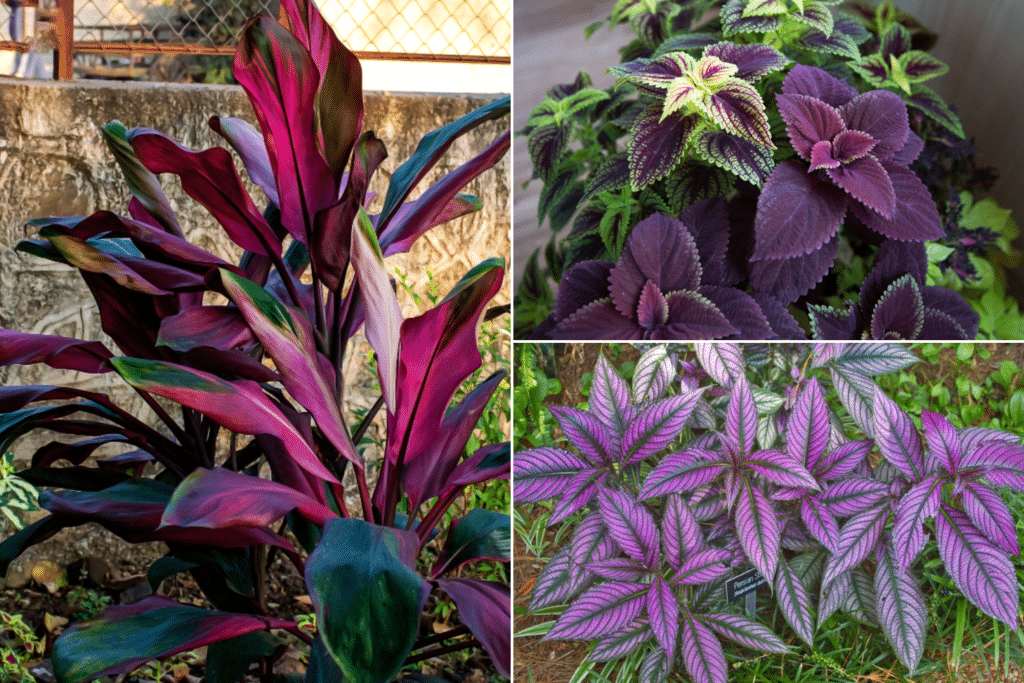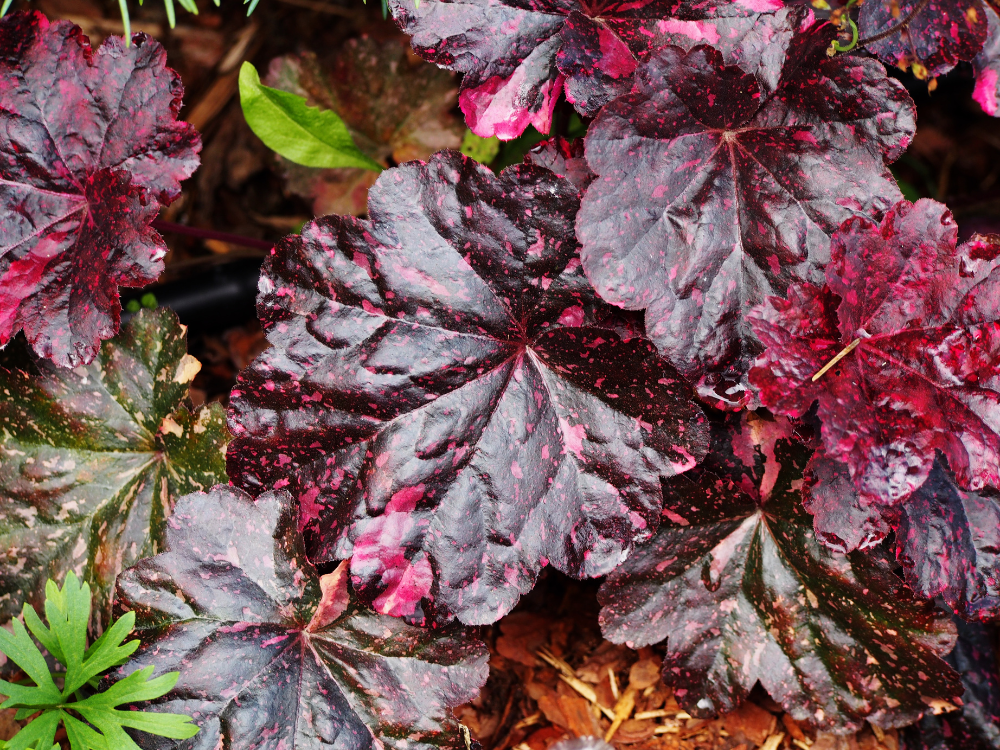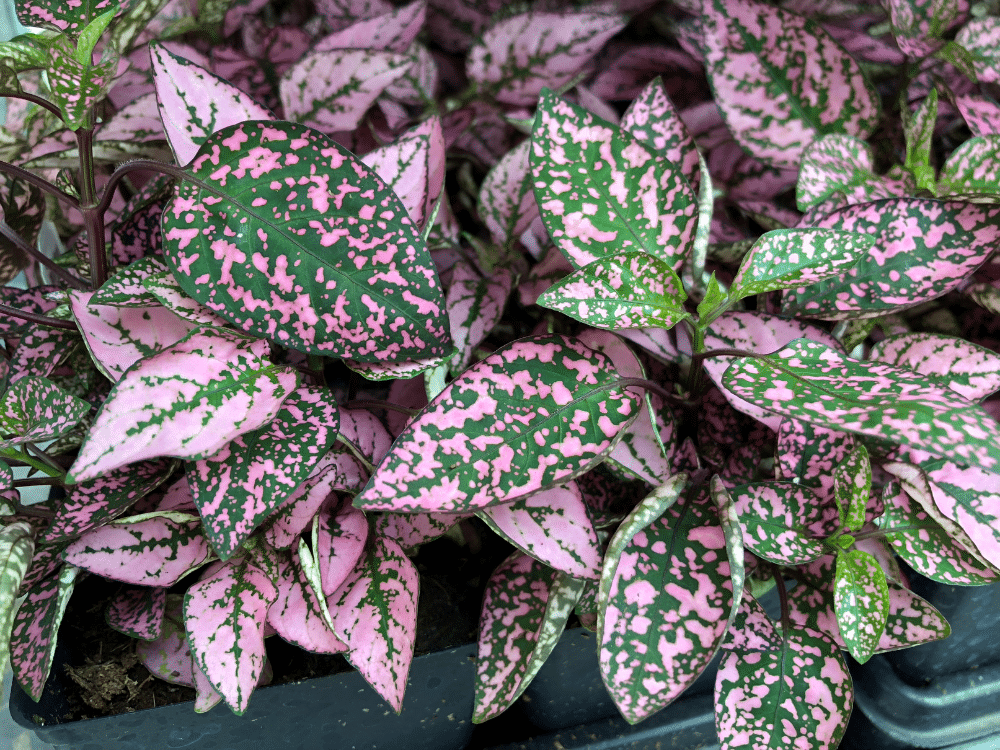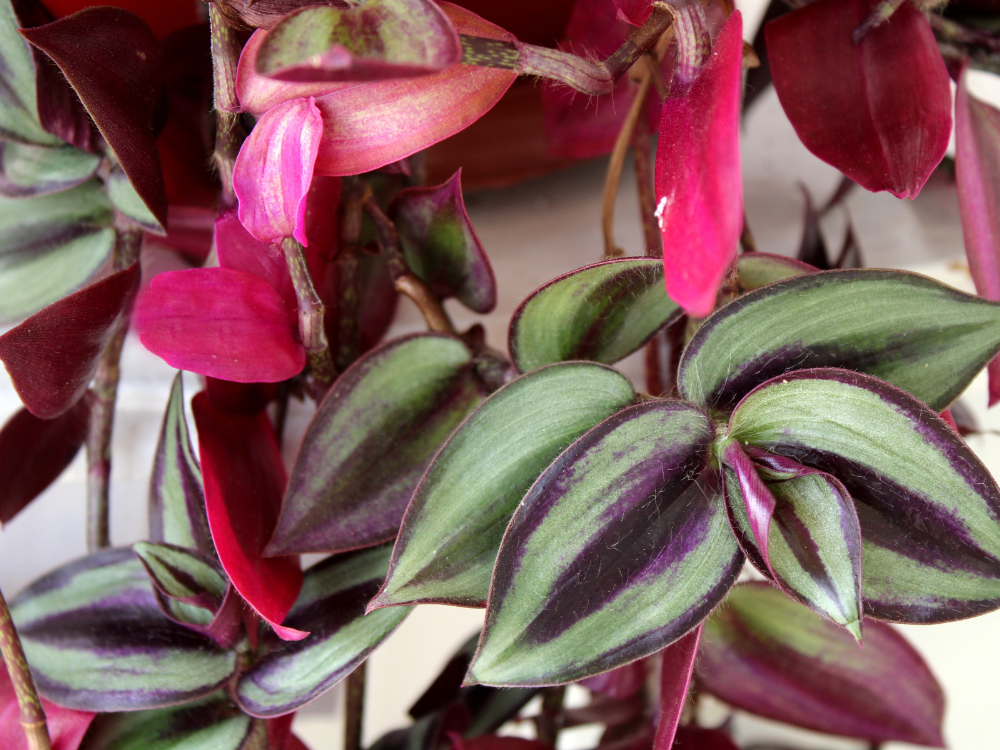Last Updated on April 21, 2024 by April

I have always adored purple leaf plants for their unique and vibrant color. These plants not only add a touch of elegance to gardens but also bring a pop of color to any landscape.
As I’ve explored my gardening hobby, I’ve come across a variety of species with beautiful purple leaves and have been amazed by their diversity.
Some well-known plants with dark purple leaves include purple shamrock, tradescantias, and Persian shield. Others like coleus, coral bells, and succulents boast multi-colored leaves with a combination of green and purple hues.
More than just their captivating appearance, I’ve learned that these plants can be utilized in many different garden styles and create striking contrasts with other green foliage or colorful flowers.
Incorporating purple leaf plants into my garden has been an exciting experience, and I am eager to continue exploring and learning about the world of purple-leafed plants.
So, let’s dive deeper into the fascinating topic and discover more about these ornamental plants that can add remarkable beauty to both indoor and outdoor gardens.
30 Purple Leaf Plant Types
As a gardening enthusiast, I always appreciate the beauty and variety of purple leaf plants. In this section, I’ll share with you some of the most attractive purple leaf plant types, classified into various categories such as trees, shrubs, perennials, annuals, groundcovers, and houseplants.
Purple Foliage Trees

Purple Leaf Filbert (Corylus maxima ‘Purpurea’): This deciduous tree is known for its twisted branches and deep purple leaves, growing up to 15 feet tall. It thrives in hardiness zones 4-8 and prefers full sun to partial shade.

Sambucus Black Beauty (Sambucus nigra ‘Black Beauty’): A stunning purple foliage tree with fragrant pink flowers, this elderberry cultivar can grow up to 8 feet tall. It is suitable for zones 4-7 and enjoys full sun or partial shade.

Acer palmatum ‘Atropurpureum’: A beautiful Japanese maple with red-purple leaves, perfect for adding color to your garden. It grows up to 20 feet tall and prefers partial shade in hardiness zones 5-8.

Purple leaf plum (Prunus cerasifera) is a deciduous tree that belongs to the Rosaceae family. It is hardy in USDA hardiness zones 4 to 9 and prefers full sun.
Purple Foliage Shrubs

Crimson Pygmy Barberry (Berberis thunbergii ‘Crimson Pygmy’): This dwarf shrub features purplish-red foliage and requires bright light for the best color. It is suitable for zones 4-7.

Cotinus coggygria ‘Royal Purple’: Also known as Royal Purple Smokebush, this deciduous shrub showcases deep purple leaves growing up to 15 feet tall. It thrives in zones 4-9 and needs full sun for optimal leaf color.

Chinese fringe flower (Loropetalum chinense) is a shrub that belongs to the Hamamelidaceae family. It is hardy in USDA hardiness zones 7 to 10 and prefers full sun to partial shade.

Purple-leaf sand cherry (Prunus x cistena) is a deciduous shrub that belongs to the Rosaceae family. It is hardy in USDA hardiness zones 2 to 8 and prefers full sun to partial shade.
Perennials with Purple Leaves

Heuchera (Coral Bells): With ruffled purple leaves, Heuchera is a versatile perennial that can be planted in hardiness zones 4-9. This plant enjoys partial shade and can grow up to 18 inches tall.

Tradescantia (Spiderwort): With vibrant purple and green leaves, this perennial thrives in zones 4-9 and prefers full sun or partial shade. It can grow up to 2 feet tall.

Purple heart (Tradescantia pallida) is a perennial plant that belongs to the Commelinaceae family. It is hardy in USDA hardiness zones 8 to 11 and prefers full sun to partial shade.

Cordyline (Cordyline fruticosa) is a tropical plant that belongs to the Asparagaceae family. It is hardy in USDA hardiness zones 10 to 12 and prefers full sun to partial shade.

‘Black Magic’ elephant ear (Colocasia esculenta ‘Black Magic’) is a tropical plant that belongs to the Araceae family. It is hardy in USDA hardiness zones 8 to 11 and prefers full sun to partial shade.
Black rose aeonium (Aeonium arboreum ‘Zwartkop’) is a succulent plant that belongs to the Crassulaceae family. It can be grown in USDA hardiness zones 9 to 11 and prefers full sun to partial shade.

Midnight rose (Cordyline ‘JURed’) is a tropical plant that belongs to the Asparagaceae family. It is hardy in USDA hardiness zones 9 to 11 and prefers full sun to partial shade.
Purple Foliage Annuals

Persian Shield (Strobilanthes dyeriana): Known for its iridescent purple leaves, this annual grows best in zones 10-11 and prefers partial shade. It can reach heights of up to 3 feet.

Coleus (Plectranthus scutellarioides): With their intricately patterned leaves in a variety of purple shades, Coleus is an eye-catching annual that thrives in hardiness zones 10-11 and can grow up to 2 feet tall.

Polka dot plant (Hypoestes phyllostachya) is an annual plant that belongs to the Acanthaceae family. It can be grown in USDA hardiness zones 10 to 11 and prefers bright, indirect light.

Purple waffle plant (Hemigraphis alternata) is an annual plant that belongs to the Acanthaceae family. It can be grown in USDA hardiness zones 10 to 11 and prefers bright, indirect light.

Ornamental pepper ‘Purple Flash’ (Capsicum annuum) is an annual plant that belongs to the Solanaceae family. It can be grown in USDA hardiness zones 9 to 11 and prefers full sun.

Purple basil (Ocimum basilicum ‘Purple Ruffles’) is an annual herb that belongs to the Lamiaceae family. It can be grown in USDA hardiness zones 9 to 11 and prefers full sun.

Purple kale (Brassica oleracea var. acephala) is an annual vegetable that belongs to the Brassicaceae family. It can be grown in USDA hardiness zones 2 to 11 and prefers full sun.

Purple lettuce (Lactuca sativa) is an annual vegetable that belongs to the Asteraceae family. It can be grown in USDA hardiness zones 2 to 11 and prefers partial shade.
Groundcovers with Purple Foliage

Purple Shamrock (Oxalis triangularis): A low-growing, dark-purple-leaved plant that serves as an excellent groundcover in zones 6-11, preferring partial shade.

Tradescantia zebrina (Wandering Jew): This fast-growing groundcover boasts purple and silver-striped leaves, thriving in zones 9-11 and preferring partial to full shade.
Gorgeous Purple Houseplants

Purple Passion (Gynura aurantiaca): Also known as Purple Velvet Plant, this houseplant has soft, velvety leaves with a deep purple hue. It prefers bright, indirect light.

Rex Begonia (Begonia rex-cultorum): A popular houseplant with striking purple leaves, it thrives in low to medium light and prefers to stay evenly moist.

Ti plant (Cordyline terminalis) is a tropical plant that belongs to the Asparagaceae family. It is hardy in USDA hardiness zones 10 to 12 and prefers full sun to partial shade.

Moses in the cradle (Tradescantia spathacea) is a perennial plant that belongs to the Commelinaceae family. It is hardy in USDA hardiness zones 9 to 11 and prefers bright, indirect light.

Ruby’s necklace (Othonna capensis) is a succulent plant that belongs to the Asteraceae family. It can be grown in USDA hardiness zones 9 to 11 and prefers full sun to partial shade.

Echeveria purple pearl (Echeveria ‘Purple Pearl’) is a succulent plant that belongs to the Crassulaceae family. It can be grown in USDA hardiness zones 9 to 11 and prefers full sun to partial shade.
Incorporating these purple leaf plants into your indoor or outdoor garden will surely add a touch of elegance and diversity, making your space even more beautiful and unique.
Purple Leaf Plant Benefits
Boosting Landscape Visual Appeal
As a gardening enthusiast, I’ve found that incorporating purple leaf plants into my landscape significantly boosts its visual appeal. The beautiful contrast between the deep purple hue and the more common green foliage of other plants can create a stunning effect. Purple leaf plants like Persian Shield and the Ti Plant offer rich color to the garden, turning an ordinary space into an extraordinary display.
Creating Dramatic Garden Displays
In addition to increasing visual appeal, I’ve also noticed how purple leaf plants help create dramatic garden displays. Plants such as the Royal Purple Smokebush and the Crimson Queen Japanese Maple have stunning foliage that adds an element of drama and sophistication to the landscape. The unique colors and textures of these plants, when combined with others, create depth and interest in a garden, making it more than just the typical green space.
Attracting Pollinators
One often-overlooked benefit of having purple leaf plants in my garden is their ability to attract pollinators, such as bees and butterflies. This helps improve the health and productivity of the entire garden ecosystem. The natural colors and ornamental aspect of these plants not only catch the human eye but also draw in vital insects that contribute to the well-being of other plants in the area.
Through the inclusion of purple leaf plants in my garden, I’ve seen first-hand how they can greatly enhance the space, adding visual interest, drama, and ecological benefits. By incorporating these stunning plants, the garden transforms into a vibrant and attractive environment that benefits both humans and pollinators alike.
Companion Plants and Garden Design
Complementing Flower Colors
When designing a garden with purple leaf plants, I consider the color palette of the flowers as well. To create a harmonious design, I combine purple leaf plants with blooms in a variety of complementary hues. For example, pairing purple leaf plants with yellow, orange, or white flowers can create a striking contrast that catches the eye, like mixing Hakone grass and hellebores. At the same time, using varying shades of purple, such as violet and lavender, can create a more subtle, cohesive feel.
Borders and Edging
Incorporating purple leaf plants into the borders and edging of a garden can provide a visually impactful framework. For instance, a low-growing plant with purple foliage, like the purple leaf filbert, can be used as a border, guiding the eye through the garden layout. This type of arrangement can also help define garden areas, such as surrounding a wine-colored hardscape or vegetable garden to enhance their visual appeal.
Accent and Specimen Plantings
I like to use purple leaf plants as accent or specimen plantings to draw attention or break up a monochromatic garden design. For instance, planting a group of purple-leafed shrubs or trees, like Sambucus Black Beauty, can create a bold focal point and provide delicious, edible nuts in the autumn. Additionally, carefully positioning a collection of purple-leaved ornamental grasses can create an eye-catching contrast against a predominantly green backdrop, enriching the overall garden experience.
In summary, I use purple leaf plants in complementary color combinations, border and edging arrangements, and as accent and specimen plantings to enhance the visual appeal and functionality of a garden. Experimenting with these design strategies allows me to create captivating gardens featuring purple leaf plants in various settings.
Unusual Varieties of Purple Leaf Plants
When it comes to purple leaf plants, there are some truly distinctive and unusual varieties in both foliage and flowers that capture my attention. My appreciation grows for purple plants when I discover unique species that create a stunning visual impact in my garden.
One unusual variety that caught my eye is the African Milk Tree, which has striking purple-mottled stems that are particularly noticeable when the sun illuminates them. This succulent plant not only displays purple hues but also has an interesting architectural shape, making it a great addition to my collection.
Another favorite of mine is Ajuga reptans ‘Black Scallop’, a low-growing ground cover with dark purple leaves that seem almost black. The contrast it provides with lighter-colored plants makes it a perfect addition to any garden landscape. Plus, it produces beautiful blue flowers that add a pop of color to my outdoor space.
When it comes to flowering plants, Bougainvillea never disappoints. This tropical vine boasts vibrant purple bracts that surround its delicate, white flowers. This versatile plant can be grown in containers, as a climber, or trimmed into a hedge, making it one of my go-to choices for purple foliage plants.
Two other purple plants that I absolutely adore are Corydalis and Geranium. Both of these perennials produce vivid blooms that come in shades of purple, adding an elegant touch to any garden. Their delicate flowers and foliage make them an excellent choice for borders or mixed beds.
Several more fantastic purple plants include:
- Anemone: A perennial that produces large, stunning purple flowers.
- Phlox: Known for its tall, fragrant flower clusters that come in various shades of purple.
- Boltonia: A perennial with lovely, aster-like purple flowers that bloom in late summer.
- Columbine: This plant features unique, spurred flowers with an array of purple hues.
- Larkspur: A tall, striking plant with dense spikes of purple flowers.
Incorporating these unusual varieties of purple leaf plants into my garden not only adds a captivating touch of color but also showcases their fascinating shapes and features.


